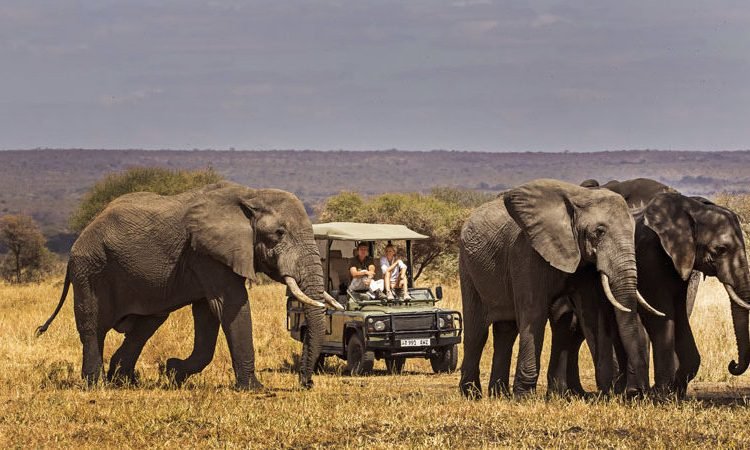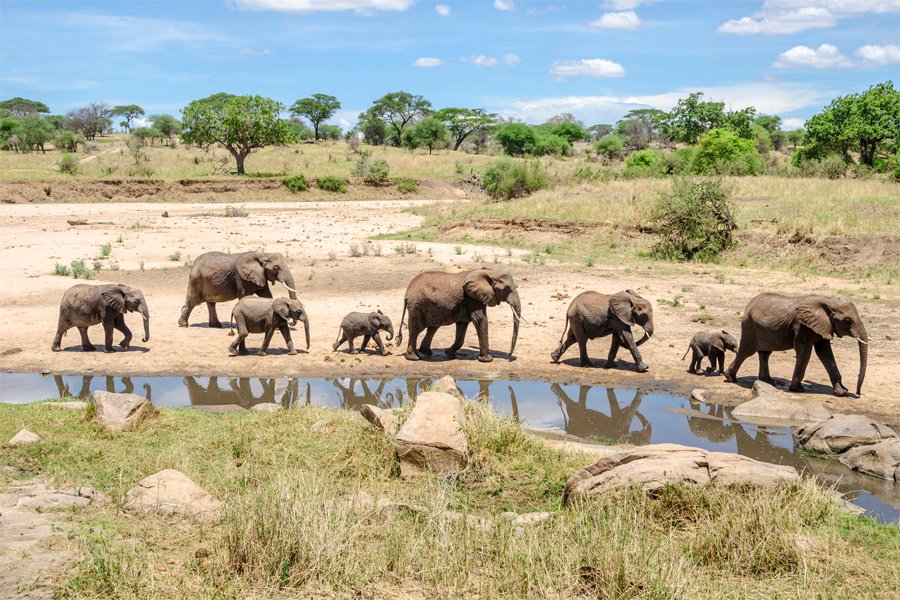Best Time to Visit Tarangire. Tarangire National Park is one of Tanzania’s most underrated safari destinations, known for its large elephant herds, diverse wildlife, and unique baobab-dotted landscapes. Planning your visit to Tarangire at the right time of year can enhance your safari experience, offering optimal wildlife sightings, weather, and stunning scenery. In this guide, we’ll explore the best time to visit Tarangire based on wildlife activity, weather patterns, and seasonal highlights
Learn more about planning your Tarangire adventure here

Best Time to Visit Tarangire – Overview: Why Timing Matters in Tarangire
Timing your visit to Tarangire is crucial to make the most of your safari. The park is a year-round destination, but wildlife concentrations and scenery vary with the changing seasons. Tarangire is known for its incredible elephant population and diverse wildlife, particularly during the dry season when animals congregate around the Tarangire River.
- Year-Round Destination: Wildlife remains in the park all year, but some months are better for viewing large concentrations of animals.
- Seasonal Highlights: Tarangire’s dry and wet seasons offer contrasting but equally fascinating experiences.
Find more about Tarangire’s unique attractions.
Best Time to Visit Tarangire – Best Time for Wildlife Viewing: June to October
The dry season, from June to October, is the best time to visit Tarangire for exceptional wildlife viewing. During these months, water sources become scarce, and animals like elephants, zebras, buffalo, and wildebeest gather around the Tarangire River, making them easier to spot. The clear skies and minimal rainfall also provide excellent conditions for game drives and photography.
- Advantages: Highest concentration of animals around water sources, minimal rain, and clear skies.
- Highlights: Large herds of elephants and big cats like lions and leopards are commonly spotted.
Discover why the dry season is ideal for safaris in Tarangire.
Best Time to Visit Tarangire – The Wet Season: November to May
From November to May, Tarangire experiences its wet season, characterized by lush green landscapes, blooming vegetation, and fewer tourists. Although the wet season sees fewer visitors, it’s an excellent time for birdwatching, as migratory birds flock to the park, and the landscape transforms into a vibrant oasis. However, wildlife is more dispersed due to abundant water sources, making animals harder to spot.
- Advantages: Fewer crowds, lower accommodation costs, and a birdwatcher’s paradise.
- Disadvantages: Wildlife is more scattered, and some roads may be muddy or difficult to traverse.
Learn more about visiting Tarangire during the green season.
Best Time to Visit Tarangire – Wildlife Migration in Tarangire
One of the main attractions of Tarangire is its mini-migration, where thousands of animals move into the park during the dry season from neighboring areas in search of water. This annual migration is lesser-known compared to the Great Migration in the Serengeti, but it offers a fantastic opportunity to witness a wide variety of wildlife.
- Best Time for the Mini-Migration: Peak wildlife migration occurs during the dry season, particularly from July to October.
- Key Species: Large herds of elephants, wildebeest, buffalo, and zebras.
Read more about the wildlife migration in Tarangire here.
Best Time to Visit Tarangire – Best Time for Birdwatching: November to April
For bird lovers, the wet season from November to April is the best time to visit Tarangire. During these months, migratory birds arrive from Europe and Asia, adding to the park’s already rich birdlife. Over 550 bird species can be spotted, including kori bustards, yellow-collared lovebirds, and the rare ashy starling, making Tarangire a prime destination for birdwatchers.
- Top Bird Species: Kori bustard, hornbills, lovebirds, and African fish eagles.
- Best Areas for Birdwatching: The wetlands and marshes attract a wide variety of waterbirds.
Explore birdwatching opportunities in Tarangire.
Best Time to Visit Tarangire – Best Time for Photography: June to September
If you’re an avid photographer, the dry season from June to September offers the best conditions for capturing Tarangire’s wildlife and landscapes. The clear skies and concentrated wildlife make for stunning photographic opportunities, especially at sunrise and sunset. The iconic baobab trees also create dramatic backdrops for wildlife photos.
- Why It’s Ideal: Clear skies, abundant wildlife, and iconic baobab landscapes.
- Pro Tip: Visit early in the morning or late afternoon for the best lighting conditions.
Get tips on safari photography in Tarangire.
Best Time to Visit Tarangire – Weather Conditions in Tarangire
Tarangire experiences a tropical climate, with distinct wet and dry seasons. Understanding the weather patterns can help you plan your safari more effectively.
- Dry Season (June to October): Warm days with cool nights; minimal rainfall.
- Wet Season (November to May): Lush, green landscapes; occasional afternoon thunderstorms, particularly from March to May.
Learn more about Tarangire’s climate and weather conditions.
Best Time to Visit Tarangire – Avoiding the Crowds: Low Season Travel
While the dry season is considered the best time for wildlife viewing, it is also the most popular time for visitors. If you prefer a more intimate safari experience with fewer tourists, consider visiting Tarangire during the shoulder season or low season (from November to May). You’ll enjoy a quieter, more peaceful experience and lower accommodation prices.
- Benefits: Fewer crowds, serene landscapes, and better deals on accommodations.
- Challenges: Wildlife may be more dispersed, and some roads may become challenging to navigate due to rain.
Discover more about the benefits of visiting Tarangire during the low season.
Best Time to Visit Tarangire – Planning Your Tarangire Safari: Practical Tips
When planning your trip to Tarangire, a few practical tips can ensure you make the most of your experience, no matter the season.
- Book in Advance: If you’re visiting during the peak dry season, it’s advisable to book your accommodations and safari in advance, as availability can be limited.
- What to Pack: During the dry season, pack lightweight clothing for the warm days and a jacket for cooler evenings. In the wet season, waterproof clothing and sturdy shoes are essential.
- Guided Safaris: Consider joining a guided safari for the best wildlife viewing and photography opportunities.
Get more tips for planning your Tarangire safari.
Combine Your Visit with Other Parks
Tarangire National Park is often included in Tanzania’s Northern Circuit, which also features popular destinations such as Serengeti, Ngorongoro Crater, and Lake Manyara. If you’re planning a longer safari, consider combining your Tarangire visit with these nearby parks to experience the diverse landscapes and wildlife that Tanzania has to offer.
- Best Time for the Northern Circuit: The dry season, from June to October, is ideal for visiting all these parks.
- Why Visit Multiple Parks: Each park offers unique wildlife and scenery, making for a varied and fulfilling safari experience.
Learn more about planning a Northern Circuit safari.

Best Time to Visit Tarangire : Conclusion
Tarangire National Park is a fantastic safari destination year-round, but your experience will vary depending on the season. For those seeking exceptional wildlife viewing, the dry season from June to October is the best time to visit. Birdwatchers and those looking for a more peaceful experience will enjoy the green season from November to May. Whichever time you choose, Tarangire’s diverse wildlife, dramatic landscapes, and iconic baobab trees will leave you with unforgettable memories.
For more information on planning your Tarangire safari, visit Kilimanjaro Climb Specialist or Eddy Tours & Safaris

